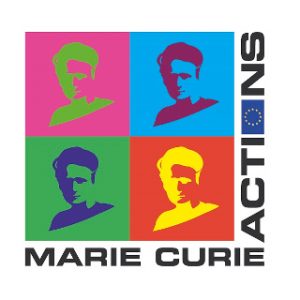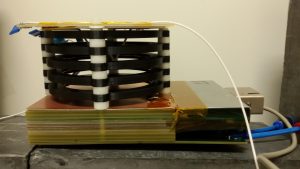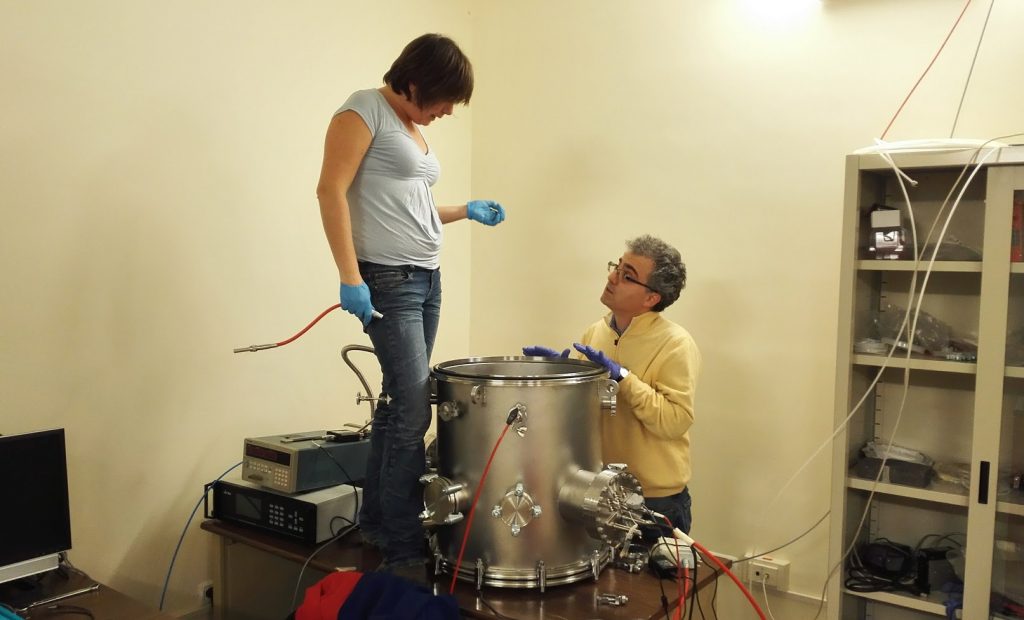 This project has been funded by european union’s horizon 2020
This project has been funded by european union’s horizon 2020 
NITEC: A NEGATIVE ION TIME EXPANSION CHAMBER FOR DIRECTIONAL DARK MATTER SEARCHES

The goal of NITEC is the construction of a Negative Ion Time Projection Chamber (NITPC) with triple Gas Electron Multiplier amplification and pixel readout (GEMPix) for directional Dark Matter (DM) searches. This project has been funded by the European Union’s Horizon 2020 research and innovation programme under a Marie Sklodowska-Curie Individual Fellowship (grant agreement 657751).
With the NITEC detector and the Beam Test Facility available at Laboratori Nazionali di Frascati, we performed measurements of ion transport properties for highly innovative negative ion gas mixtures based on SF6 never tested before. We demonstrated the high amplification capability of thin GEMs also in this environment and proved for the first time the possibility of negative ion operation at nearly atmospheric pressure with a He:CF4:SF6 mixture at 610 Torr [1]. This opened the doors for a realistic development of a NITPC at 1 bar, that is the subject of the INITIUM project.
Negative ion drift is a peculiar modification of the conventional TPC approach, where an highly electronegative molecule is added to the bulk gas [2]. In this configuration, primary electrons liberated by the track during gas ionization are captured at very short distances (<= 100 um) by the electronegative molecules. The resulting anions drift to the anode where they are ionized and normal electron avalanche occur. Since the anions act as image carriers instead of the electrons, their higher mass reduces longitudinal and transversal diffusion down to the thermal limit without need of magnetic fields. An additional decisive feature of negative ions drift is the presence of minority charge carriers: since the mobility is inversely proportional to the anions masses, the difference between the various charge carriers arrival time at the anode effectively provides a trigger-less fiducialization of the event [3]. This peculiar characteristic recently allowed the DRIFT experiment to identify all its remaining background coming from the detector walls and to publish a background-free result [4].
The GEMPix [5] is obtained coupling three standard CERN thin GEMs with a 3 × 3 cm2 active area to a Quad-Timepix ASIC with 262,144 pixels for readout, directly sensitive to the deposited charge (no silicon sensors).
Thin GEMs [6] are MPGD composed by a very thin kapton insulating foil ∼ 50 μm thick, electroplated with a conductive metal (copper) on both sides, where 50 μm width holes are etched with a chemical process. If a voltage is applied between the two side of the GEM foil, a very high electric field is generated in the holes up to 100 kV/cm. When an electron traverses the hole, avalanche multiplication takes place giving approximately 20 secondary electrons for each primary electron (with the exact value depending on gas density, gas mixture and applied electric field). The triple GEMs configuration provide not only higher gas gain but also higher stability, with respect to single or double GEMs. In the GEMPix, the GEM foils are held rigid by gluing them to a frame and then superimposing them on top of the pixels chip. The system is powered by a dedicated high voltage supply developed by Laboratori Nazionali di Frascati [7], which works as an active HV divider, with seven floating independent channels (for the 3 GEMs, plus the two transfer fields, the induction field and the drift field, not used in NITEC) isolated up to 5 kV to GND, each with a high sensitivity (nA) current meter.
Timepix [8] is the second generation of the Medipix chip family, and is fabricated in the IBM 250 nm CMOS process, with a 256 × 256 matrix of 55 × 55 μm2 square pixels. The processing electronics, including preamplifiers, discriminator threshold and pseudo-random counter (with 11818 counter depth), fit inside the footprint of the overlying pixel so that each one operates as an independent element. Since in our system the detecting medium is the gas, the silicon sensors are removed so that the pixels are directly sensitive to the deposited charge.
The Timepix can be operated in counting mode (Medipix), but also in Time Of Arrival (TOA) or Time Over Threshold (TOT) mode, thanks to a counting clock with an adjustable frequency up to 100 MHz which is propagated to every pixel, allowing to measure time or charge deposited. In TOA mode, the pixel counts the number of clk from when the preamplifiers exceeds the threshold to the end of the frame, while in TOT mode it counts the number of clk during which the signal is above threshold. This allows each pixel to act as a Wilkinson type ADC measuring the discharge time of the preamplifier. A very important and distinctive feature of the Timepix, not available in other chips used in this field (i.e. ATLAS chips in D3 [9]) or in commonly employed DAQ electronics, is the adjustable sampling frequency, that can be lowered down to 50 kHz, allowing a gate window up to nearly 0.25 s. This is of paramount importance when working with negative ions drift, where typical sampling frequencies of 40-50 MHz are too fast since anions velocity is 1000-10000 times slower than electrons.
- “TPC-GEMs R&D for directional DM searches”, talk given at “CAASTRO-CoEPP Joint Workshop: Connecting Astrophysical Dark Matter with Direct Detection”, Melbourne, Australia: http://www.caastro.org/files/58/1637200254/baracchini_caastro_coepp_jan_2017.pdf
- “NITEC: a Negative Ion Time Expansion Chamber for directional Dark Matter searches”, talk given at “Identification of Dark Matter 2016”, Sheffield: https://indico.shef.ac.uk/indico/event/0/session/7/contribution/65
[1] E. Baracchini et. al, JINST 13 (2018) no.04, P04022
[2] C.J.Martoff et al, NIM A 440 355, T. Ohnuki et al, NIM. A 463
[3] D. P. Snowden-Ifft, Rev. Sci. Instrum. 85 (2014) 013303. doi:10.1063/1.4861908
[4] J. B. R. Battat et al. [DRIFT Collaboration], Phys. Dark Univ. 9-10 (2015) 1 doi:10.1016/j.dark.2015.06.001 [arXiv:1410.7821 [hep-ex]].
[5] S. P. George, F. Murtas, J. Alozy, A. Curioni, A. B. Rosenfeld and M. Silari, JINST 10 (2015) no.11, P11003. doi:10.1088/1748-0221/10/11/P11003
[6] F. Sauli, Nucl. Instrum. Meth. A 805 (2016) 2. doi:10.1016/j.nima.2015.07.060
[7] G. Corradi, F. Murtas and D. Tagnani, Nucl. Instrum. Meth. A 572 (2007) 96. doi:10.1016/j.nima.2006.10.166
[8] X. Llopart, R. Ballabriga, M. Campbell, L. Tlustos and W. Wong, Nucl. Instrum. Meth. A 581 (2007) 485 Erratum: [Nucl. Instrum. Meth. A 585 (2008) 106]. doi:10.1016/j.nima.2007.08.079, 10.1016/j.nima.2007.11.003
[9] J. B. R. Battat et al., Phys. Rept. 662 (2016) 1 doi:10.1016/j.physrep.2016.10.001 [arXiv:1610.02396 [physics.ins-det]].

